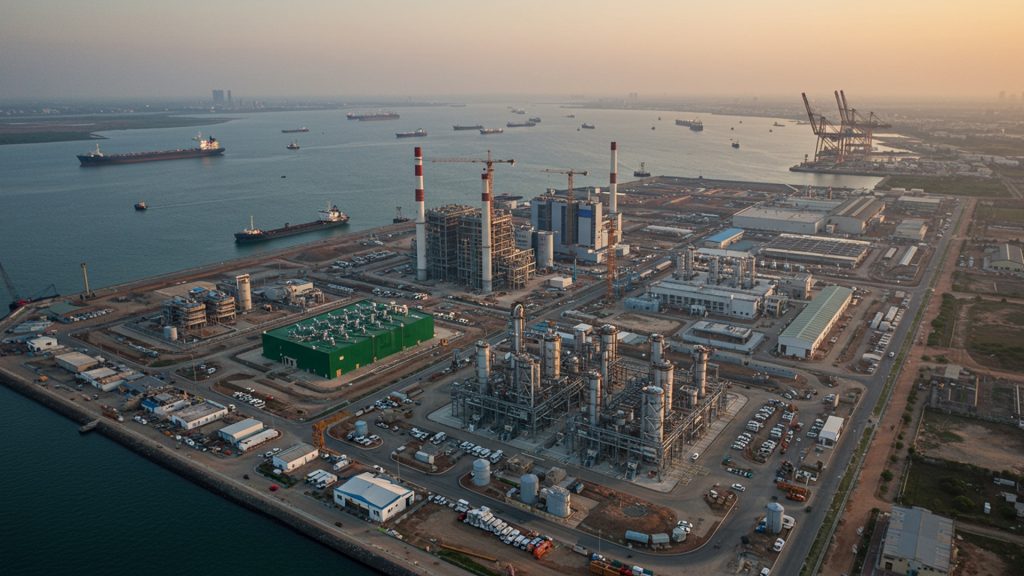Larsen & Toubro (L&T) and ITOCHU Corporation are joining forces to build a large green ammonia plant at Kandla, India. This major step marks a big move toward making clean fuel for a better world. The new project will make green ammonia, a type of fuel that does not harm the air, which is very essential as countries work to cut down on bad gases. This partnership highlights the urgent need to find new ways to power homes and industries without hurting the Earth, putting Kandla at the center of a new green energy push.
About the New Partnership
L&T Energy GreenTech (LTEG), which is a full-owned company of Larsen & Toubro (L&T), has joined hands with Japan’s ITOCHU Corporation. They have signed an agreement to work together on a large project. This project will build a green ammonia plant in Kandla, located in Gujarat, India. The goal is to make 300,000 tonnes of green ammonia every year. This new plant will help make India a key player in the global market for green ammonia. The green ammonia made here will mostly go to Singapore. It will be used as ship fuel there to help make shipping cleaner. The agreement marks a big step forward in finding clean energy solutions for the shipping industry. Both companies are focused on making things sustainable and reducing harmful releases into the air.
What is Green Ammonia?
Green ammonia is a type of ammonia made using renewable energy sources, like power from the sun or wind. This process avoids using fossil fuels, which are known to cause air pollution. When ammonia is made this way, it has very low carbon emissions. It is seen as a promising fuel for ships and other industries because it does not pollute the air like regular fuels. Using green ammonia can help reduce the amount of carbon released by ships, which is a major goal for the shipping world. The International Maritime Organization (IMO) has set targets to make shipping cleaner. Replacing old ship fuels with green ammonia will play a big part in reaching these targets. This helps to lower the carbon footprint of the shipping business and supports the move to a global energy system that is better for the environment.
Why Kandla is essential
Kandla, which is on the west coast of India, has many good points for making and sending out large amounts of green energy. L&T had already bought a big piece of land in Kandla last year. This land was bought to set up projects for green hydrogen and green ammonia. This new plan with ITOCHU makes L&T’s long-term goal stronger. L&T wants to be active in every part of the green energy chain, from making it to using it. India has a lot of renewable energy sources, like sun and wind. Also, the cost of electricity in India is good for such projects. The country also has strong plans under its National Green Hydrogen Mission. Because of all these things, the new plant in Kandla is expected to become an essential place for sending out green energy to other countries. ITOCHU sees Kandla as the main place to make green ammonia for its ship fueling operations in Singapore.
Looking at Company Goals
Both Larsen & Toubro and ITOCHU Corporation have clear reasons for this partnership. For L&T, through its subsidiary LTEG, this project supports its bigger plan to be a leader in the green energy field. They want to be involved in all steps of making and using clean energy.
Subramanian Sarma, who is a top leader at L&T, said: “As the global energy world moves firmly towards being sustainable, L&T stays deeply committed to leading the shift to clean energy through new ideas, smart partnerships. great engineering. This partnership with ITOCHU shows L&T’s larger goal of helping create a cleaner, greener future by focusing on businesses that are good for the environment.”
ITOCHU, a big Japanese trading company, has a lot of experience in energy projects. They are actively building a worldwide supply chain for clean ammonia. ITOCHU has already started a project to use a special ship for fueling other ships with ammonia in Singapore. This ship is planned to be ready by 2027. This partnership with LTEG will make sure that ITOCHU has a steady and long-term supply of green ammonia to power ships.
Hiroyuki Tsubai, a high-ranking official at ITOCHU Corporation, added: “Working together with one of India’s biggest and most respected private companies, L&T Group, will make our efforts to bring low-carbon ammonia to the shipping world as a fuel that causes no pollution even stronger. With this partnership, Kandla, on India’s west coast, will become the main place for making green ammonia for ITOCHU’s fueling work in Singapore.”
This shows how the strengths of an Indian engineering company and a Japanese trading giant are coming together to make essential changes in the energy world.
Big Picture for India and the World
This joint project fits very well with India’s National Green Hydrogen Mission. This mission aims to make at least 5 million tonnes of green hydrogen (and its products like green ammonia) every year by 2030. This plan is expected to bring in more than 100 billion US dollars in investments. India is in a good position to become a world leader in green hydrogen. This is because the country has a lot of natural resources for renewable energy and electricity costs that are not too high. This partnership between L&T and ITOCHU is a sign of a new time for international cooperation. Such efforts are aimed at reaching goals like zero net pollution, making sure energy supplies are secure. building an energy system ready for the future. The table below shows some key facts about the project:
| Project Detail | data |
| Location | Kandla, Gujarat, India |
| Partners | L&T Energy GreenTech (LTEG) and ITOCHU Corporation |
| Product | Green Ammonia |
| Annual Production Capacity | 300,000 tonnes |
| Main Use of Product | Ship fueling (bunkering) in Singapore |
| Purpose | To help shipping become cleaner (decarbonization) |
The project will help bring together India’s engineering skills and Japan’s global trade knowledge. This will speed up the move towards fuels that do not harm the environment for shipping. As Kandla grows as a central point for green ammonia, this partnership shows how countries can work together to achieve essential environmental goals.

